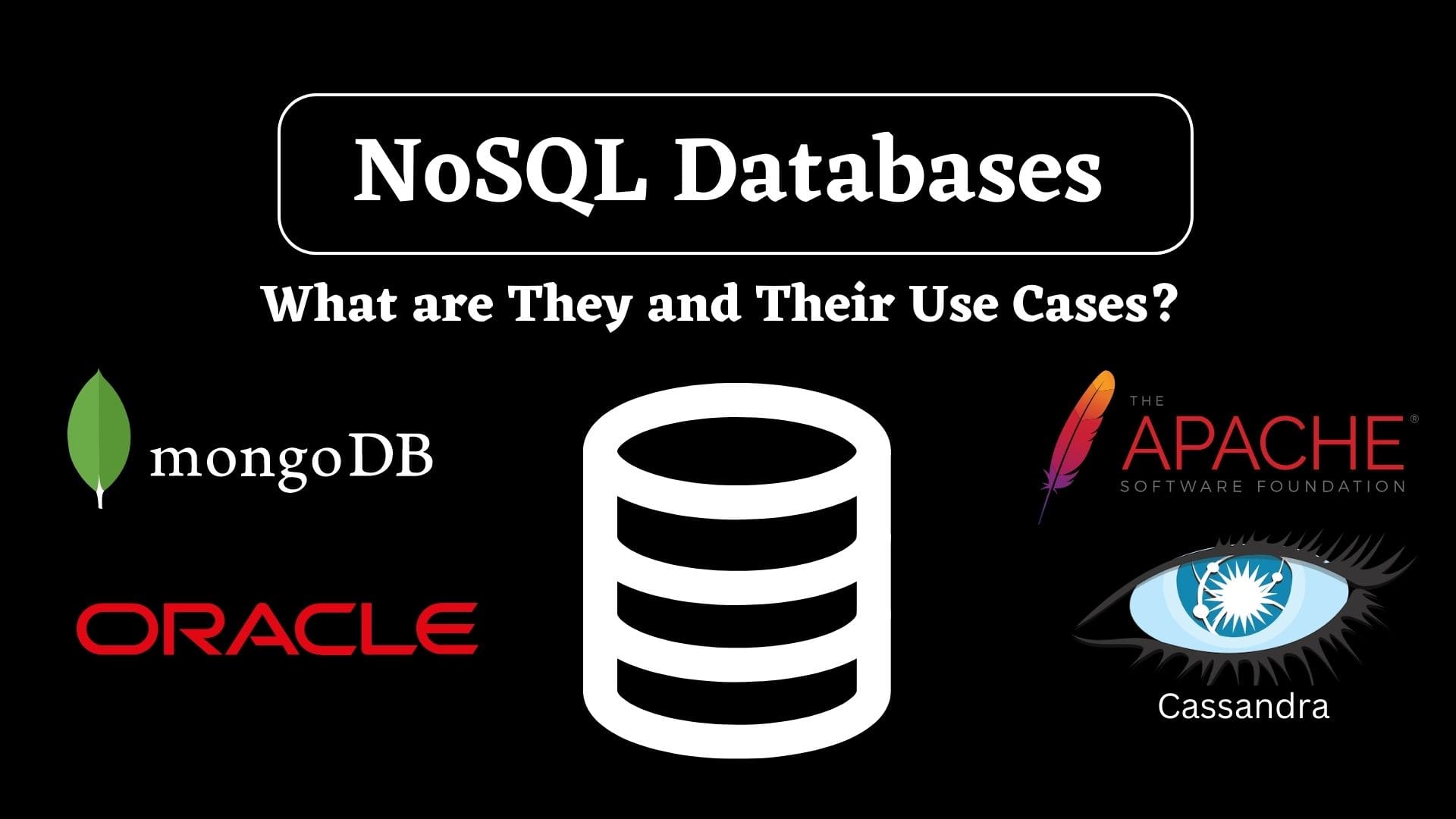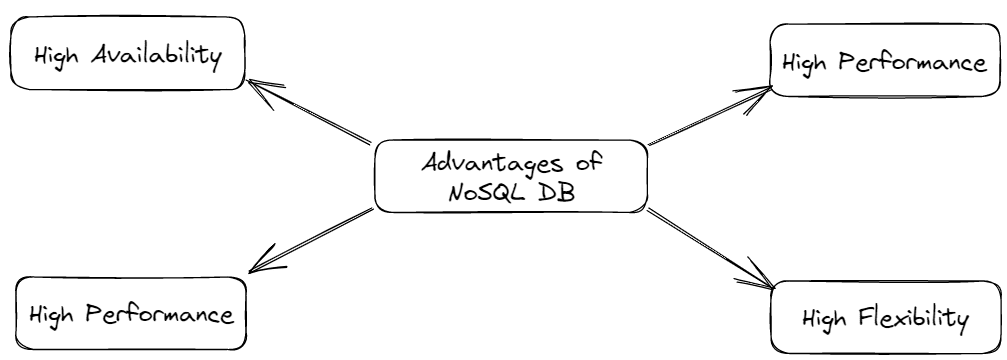NoSQL Databases and Their Use Cases
Learn about NoSQL Databases and their types like key-value, document, graph and column family with their use cases.

Image by Author
In the 1970s, Edgar F. Codd proposed the relational database model, commonly known as SQL databases. These databases are mainly designed for handling structured data having relational models. They can handle transactional data, which involves storing and manipulating data in tables with predefined schemas. Famous examples of SQL databases are MySQL, PostgreSQL, and Oracle Server.
In the 1980s, they gained immense popularity, but after that, the demand and volume of data increased, and the need for different data types became more diverse to the point where SQL databases struggled. In addition to that, they are complicated for horizontal scaling, which makes them not suitable for handling large amounts of data.
To cater to these limitations of SQL databases, in the early 2000s, NoSQL databases came into the picture. They are document-oriented databases and use fast key-value pairs to store data. They are capable of parsing data from the documents and storing that data under keys rather than defining strict tables of information, unlike SQL databases.
NoSQL databases have now become mainstream and provide various advantages over SQL databases. But it does not necessarily mean that NoSQL databases are better than SQL. Both SQL and NoSQL databases serve different purposes and use different approaches to data management. One is used for relational data, and the other is for non-relational data. SQL databases are still in use where there is a need to run complex queries, and the database schema is well-defined. Famous examples are MongoDB, Cassandra, Neo4J and Redis.
But NoSQL databases are better than SQL databases in certain areas discussed below.
Advantages of NoSQL Databases
Below are some key features where NoSQL databases perform better than SQL databases.
- Flexibility:
It means that data can be dynamically added or removed without changing the structure of the original database. It means unlike SQL databases, they don't require rigid schemas. They are designed to handle any data format structured, semi-structured or unstructured. This gives freedom for the developers to focus on the application development rather than worrying about the database schema.
- Scalability:
NoSQL databases support horizontal scaling, which means we can scale it by adding more servers instead of increasing the capacity of a single server. This makes it more powerful to handle large numbers of requests.
- High Availability:
Due to its feature of replicating its database across multiple servers, it provides very low latency and almost zero downtime to its users. Also, they divide the traffic among themselves to reduce the burden on a single server.
- Performance:
They are designed to optimize the read and write performances, making them suitable for real-time data processing applications where daily tera-bytes of data are generated. They have a faster query response time and support database sharding, improving their overall performance.

Image by Author
These are some points where NoSQL databases perform better than SQL databases. The following section will discuss the types of NoSQL databases and their use cases.
Types of NoSQL Databases
There are various types of NoSQL databases, each having its own benefit and limitations. Below we have discussed some popular ones:
Key-Value
This is the most flexible NoSQL database. It requires a key-value pair for storing data. A key can be a unique attribute, like an id, that corresponds to a particular value. The application has control to store any type of data in the value field. These are suitable for real-time applications, caching, or session management. Redis and Riak are famous examples of key-value databases.
Use Case:
This database is best suited for e-commerce platforms where large amounts of customer-related data like orders, user profiles, and product catalogs are generated daily. Due to its low latency and quick processing, it is suitable for real-time inventory management and handling high traffic.
Document-Oriented
These databases store data in documents, mainly in the form of JSON objects. This is most suitable for storing semi-structured or unstructured data, where there is no need to specify the document's fields explicitly. MongoDB is a famous example of a document-oriented database.
Use Case:
This is best suited for Content Management Systems, for example, a blogging website. Data in the form of articles, comments, categories, and tags can be stored and retrieved quickly. Document-based data is suitable for storing unstructured data like texts, images, links, etc. Also, its flexible schema behaviour allows easy changes in the data model.
Graph Databases
This type of NoSQL database is most suitable for data that are strongly interconnected to each other. They store data in the form of nodes and edges and are used to represent complex relationships between objects. It is best suitable for social media applications and for creating recommendation engines. Famous examples are Neo4J and InfoGrid.
Use Case:
They are most suited for creating recommendation engines. Take the example of Youtube, which recommends videos to users based on their viewing history. Graph databases can store and process interconnected data and quickly deliver relevant content.
Column-based Databases
In this type of NoSQL database, the data is stored in column families. Similar types of data are grouped into cells and stored in columns of data instead of rows. A column can even contain multiple rows and columns inside it, which have their own unique id.
In a traditional SQL database, the query executes row by row. But in the columnar database, the query executes only for the specific column we want. This saves time and makes it suitable for handling large datasets. They may look like a SQL database, as they involve some form of schema management and function the same way as relational table works. But they are far more flexible and efficient than SQL databases, making them in the NoSQL databases category.
Popular examples of columnar databases are Apache HBase and Apache Cassandra. You can read this article by Alex Williams for more information about this topic.
Use Case:
Column-family databases are best suited for data warehousing applications. These applications require analyzing large amounts of data for business intelligence with a high write throughput, and column-family databases completely take charge of it.

Different types of NoSQL Databases | Image by Author
Conclusion
In this article, we have learnt what NoSQL databases are and a glimpse of the fundamental difference between SQL and NoSQL databases. Then, we discussed the popular types of NoSQL databases along with their use cases.
There is always a What to Choose? between SQL and NoSQL databases. To make the proper selection, first, you must understand your application's use case, data model, scalability, and performance, and then decide.
I hope you enjoyed reading the article. If you have any comments or suggestions, please contact me on Linkedin.
Aryan Garg is a B.Tech. Electrical Engineering student, currently in the final year of his undergrad. His interest lies in the field of Web Development and Machine Learning. He have pursued this interest and am eager to work more in these directions.
